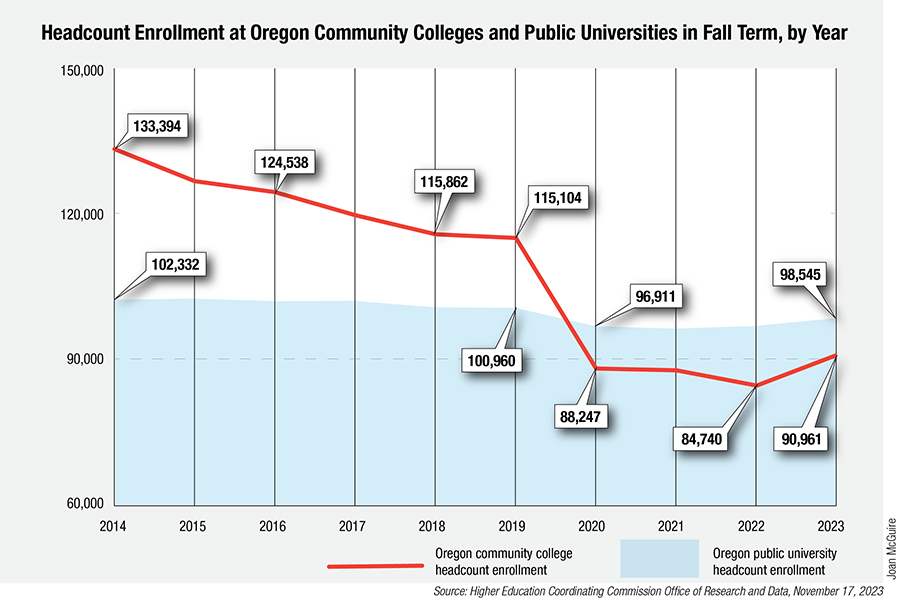Schools around the state saw upticks but headcounts have yet to return to pre-COVID levels.
Enrollment in Oregon’s community colleges is up slightly for the second year in a row. It’s modest good news for schools that have lately faced existential worries.
This week, the Portland Business Journal examined enrollment figures from Oregon and Southwest Washington and noted that while students are returning to community college campuses around the state, their numbers are still far from prepandemic levels.
Peak community college enrollment in the U.S. occurred following the financial crisis of 2008 as millions of adults returned to school for job training. But over the next decade, as economic conditions improved, community college enrollment fell precipitously. And it fell even faster when the pandemic hit.
In the Northwest, the 18 community colleges of Oregon and Southwest Washington served 367,000 students around the time of the Great Recession. By 2021-2022, that number had dropped to 194,000. Now, following two years of small increases, the figure is up to 210,000.
This change occurred as enrollment in four-year institutions remained fairly stable. In the first year after the pandemic, headcount enrollment at Oregon’s public universities dropped from 100,690 to 96,911 and it has since climbed to 98,545.
Over the past two years, all 18 community colleges in Oregon saw increased enrollment. Klamath Community College saw the largest jump with an increase of around 19%. The state’s biggest community college, Portland Community College, drew 50,596 full-time equivalent students, an increase of .2% over the prior year. (Disclosure: the author of this story will be teaching part-time at PCC later this year.)
Those enrolled in community colleges are facing increased costs. In the past two years, community college tuition in Oregon increased by an average of around 7.5%, or from $5,926 to $6,381.
Ten million people attend the country’s more than 1,000 community, junior and technical colleges. These institutions serve an intermediary role between high school and four-year institutions, offering GED programs, English as a second language courses and associate degrees in subjects from business to social science to art. They partner with local employers to provide hands-on experience, allow high schoolers to pick up dual enrollment credits and prepare students to transfer to four-year schools.
Declining enrollment isn’t just bad for these schools, which rely on tuition dollars to fund operations. States and local communities have long relied on two-year colleges to provide workforce training in critical fields like healthcare and emergency services. Community colleges also tend to serve higher numbers of minority students compared to four-year schools. And with a lower cost and more open admissions policies, they provide low-income students a means to enter into the middle class.
Experts believe there are several factors behind the drop in two-year enrollment. Costs continue to climb at community colleges, though not as steeply as at four-institutions. (Most public universities in Oregon charge more than twice what community colleges do.)
Other theories include technological hurdles and a lack of student support systems that may prevent students from forming deep connections at their school. Beyond that, there’s strong evidence Americans are reconsidering the value of a college degree, as the cost of college rises and students take on more debt to graduate.
Click here to subscribe to Oregon Business.



